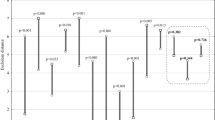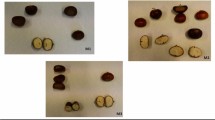Abstract
Candy was prepared with 3 different combinations of honey and carrot by using 750 g honey + 1,000 g carrot (T1), 1,000 g honey + 1,000 g carrot (T2) and 1,250 g honey + 1,000 g carrot (T3). To establish the best product, sensory evaluation was done on 9-point Hedonic scale. T1 was found to be most preferred candy. Further the T1 candy was assessed for overall quality during storage at room temperature (25–30 °C) for 6 months. Candy can be preserved safely for 6 months in both glass and LDPE packaging materials.
Similar content being viewed by others
References
Alam A (1999) Industrial and policy issues including export potential of jaggery and khandsari industry in India. Indian Institute of Sugarcane Research, Lucknow
Bajwa U, Gupta M (2007) Quality evaluation of carrot-milk cake marketed in Ludhiana. J Food Sci Technol 44:70–73
Berthold R Jr, Benton AW (1968) Creamed honey-fruit spreads. Food Technol 22(1):83–84
Billerback FW, Everett LH, NcGowan PG, Pettinga PV (1976) Sweetened storage stable peanut bultis spread and method of manufacture. United States Patent US4000322
Candert P (1971) Making long life bread. West German Patent Appl 2(012511)
Chandu N, Prasad M (2006) Development of guava candies. J Food Sci Technol 43:210–212
Colangelo K (1980) Combo packed yoghurt and granola gives convenience a healthy image. Dairy Field 163(10):95–96, 98, 100
Fast RB, Hreschak BO, Spotts CE (1971) Honey-Graham Cereal. US Patent, 3554, 763
Gupta M, Bajva U, Sandhu KS (2005) Optimization of variables associated with processing of carrot-milk cake. J Food Sci Technol 42:16–22
Kaikadi MA, Chavan UD, Adsule RN (2006) Studies on preparation and shelf-life of ber candy. Bev Food World 33:49–50
Madan S, Dhawan SS (2005) Development of value added product ‘CANDY’ from carrots. Process Food Ind 8(3):26–29
Manay SN, Shadaksharaswamy M (1997) Foods facts and principles, 3rd edn. New Age International (P) Ltd, New Delhi, pp 206–207
Mandal RC, Nambiar PTN (2002) Agricultural statistics techniques and procedure. Agrobios, Jodhpur, India
Manjunatha SS, Mohan Kumar BL, Das Gupta DK (2003) Development and evaluation of carrot kheer mix. J Food Sci Technol 41:310–312
Mehta U, Bajaj S (1984) Changes in the chemical composition and organoleptic quality of citrus peel candy during preparation and storage. J Food Sci Technol 21:422–424
Molen PC (1992) The antibacterial activity of honey. 1. The nature of antibacterial activity. Bee World 73:5–28
Naveena BM, Sen AR, Vaithiyanathan S, Muthukumar M, Babji Y (2007) Effect of honey and vitamin C on quality of microwave cooked chicken patties. J Food Sci Technol 44:505–508
Premavalli KS, Arya SS (1991) Effect of vegetables oils on the stability of carotenoids in Carrot-Halwa. Indian Food Pack 45(4):22–26
Ranganna S (1986) Handbook of analysis and quality control for fruit and vegetable products, 2nd edn. Tata Mc Graw-Hill Publ. Co. Ltd, New Delhi
Ribeiro MS, Sabaa-Srur AUO (1999) Mango (Mangifera indica L.) cv. ‘Rosa Saturation’ with sugars. Cien Technol Aliment 19:118–122
Saxena SK, Jaiswal V (2005) Wonders of golden liquid honey. Process Food Ind 8(10):42–50
Schmidt M (1978) Honey waffle. German Federal Republic Patent Application 2701765
Shamala TR, Jyothi YS (1999) Honey—It is more than just sweet. Indian Food Ind 18:349–357
Sharma S, Dhaliwal YS, Kalia M (1998) Canied apple: a new perspective. J Food Sci Technol 35:79–82
Singh P, Kulshrestha K (2008) Nutritional quality of food supplements based on carrot powder and grits. J Food Sci Technol 45:99–101
Singh N, Singh SJ, Bava AS, Sekhon KS (1988) Honey—Its food uses. Indian Food Pack 42(6):15–16
Srivastava PR, Kumar S (1994) Fruit and vegetable preservation Principles and practices. International Book Distributing co., Ltd, Lucknow
Srivastava AK, Singh OP, Srivastava PK (2006) Development of jaggery based petha (ash gourd) candy, its quality evaluation and study on stability under ambient and refrigerated storage. Bev Food World 33:71–73
Verma S, Srivastava PK, Durrani A (2006) Organoleptic characteristics of honey based amla murabba. 40th ISAE Annual Convention, Tamilnadu Agricultural University, Coimbatore, 19–21 Jan
Voll H (1974) New adaptation of honey to bread making. Bakers Dig 48(4):45, 48–49, 53
Author information
Authors and Affiliations
Corresponding author
Rights and permissions
About this article
Cite this article
Durrani, A.M., Srivastava, P.K. & Verma, S. Development and quality evaluation of honey based carrot candy. J Food Sci Technol 48, 502–505 (2011). https://doi.org/10.1007/s13197-010-0212-0
Revised:
Accepted:
Published:
Issue Date:
DOI: https://doi.org/10.1007/s13197-010-0212-0




